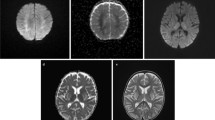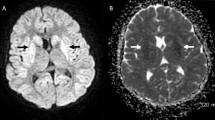Abstract
Background
The aim of this study was to analyze the neurological involvement and outcome in pediatric patients with hemolytic uremic syndrome (HUS) during the 2011 epidemic caused by Escherichia coli O104:H4.
Methods
Clinical data and data from magnetic resonance imaging (MRI) scans and electroencephalography (EEG) during the acute phase of the disease and during follow-up at 3 and 6 months were analyzed in 50 patients. Twenty-five of these patients underwent neuropsychological testing (WISC IV) during follow-up.
Results
Neurological involvement (stupor or coma, seizures, visual disturbances, paresis, myocloni) was initially observed in 14/50 (28 %) patients. One patient died. EEG abnormalities were more frequent in patients with neurological involvement than in those without (12/14 vs. 13/25, respectively). Cranial MRI scans were analyzed in nine patients with neurological involvement, of whom five showed abnormal findings. At the 3- and 6-month follow-ups, EEG abnormalities were found in 14/40 (35 %) and 7/36 (19 %) patients, respectively, whereas 28/42 (67 %) and 17/39 (44 %) patients, respectively, complained about on-going reduced performance. Neuropsychological testing showed a slightly lower global intelligence quotient in patients with neurological involvement versus those without (113.4 ± 2.8 vs. 119.4 ± 1.8, respectively).
Conclusions
Neurological involvement was frequent in our cohort. Accordingly, the incidence of pathological EEG findings was high, even in patients without clinical signs of neurological involvement. Nevertheless, major neurological sequelae were rare, and neuropsychological outcome was favorable after 6 months.

Similar content being viewed by others
References
Tarr PI, Gordon CA, Chandler WL (2005) Shiga-toxin-producing Escherichia coli and haemolytic uraemic syndrome. Lancet 365:1073–1086
Pennington H (2010) Escherichia coli O157. Lancet 376:1428–1435
Scheiring J, Rosales A, Zimmerhackl LB (2010) Clinical practice. Today's understanding of the haemolytic uraemic syndrome. Eur J Pediatr 169:7–13
Trachtman H, Austin C, Lewinski M, Stahl RA (2012) Renal and neurological involvement in typical Shiga toxin-associated HUS. Nat Rev Nephrol 8:658–669
Meuth SG, Gobel K, Kanyshkova T, Ehling P, Ritter MA, Schwindt W, Bielaszewska M, Lebiedz P, Coulon P, Herrmann AM, Storck W, Kohmann D, Muthing J, Pavenstadt H, Kuhlmann T, Karch H, Peters G, Budde T, Wiendl H, Pape HC (2013) Thalamic involvement in patients with neurologic impairment due to Shiga toxin 2. Ann Neurol 73:419–429
Eriksson KJ, Boyd SG, Tasker RC (2001) Acute neurology and neurophysiology of haemolytic-uraemic syndrome. Arch Dis Child 84:434–435
Otukesh H, Hoseini R, Golnari P, Fereshtehnejad SM, Zamanfar D, Hooman N, Tabarroki A (2008) Short-term and long-term outcome of hemolytic uremic syndrome in Iranian children. J Nephrol 21:694–703
Rooney JC, Anderson RM, Hopkins IJ (1971) Clinical and pathologic aspects of central nervous system involvement in the haemolytic uraemic syndrome. Proc Aust Assoc Neurol 8:67–75
Sheth KJ, Swick HM, Haworth N (1986) Neurological involvement in hemolytic-uremic syndrome. Ann Neurol 19:90–93
Hahn JS, Havens PL, Higgins JJ, O'Rourke PP, Estroff JA, Strand R (1989) Neurological complications of hemolytic-uremic syndrome. J Child Neurol 4:108–113
Nathanson S, Kwon T, Elmaleh M, Charbit M, Launay EA, Harambat J, Brun M, Ranchin B, Bandin F, Cloarec S, Bourdat-Michel G, Pietrement C, Champion G, Ulinski T, Deschenes G (2010) Acute neurological involvement in diarrhea-associated hemolytic uremic syndrome. Clin J Am Soc Nephrol 5:1218–1228
Schlieper A, Orrbine E, Wells GA, Clulow M, McLaine PN, Rowe PC (1999) Neuropsychological sequelae of haemolytic uraemic syndrome. Investigators of the HUS Cognitive Study. Arch Dis Child 80:214–220
Gitiaux C, Krug P, Grevent D, Kossorotoff M, Poncet S, Eisermann M, Oualha M, Boddaert N, Salomon R, Desguerre I (2013) Brain magnetic resonance imaging pattern and outcome in children with haemolytic-uraemic syndrome and neurological impairment treated with eculizumab. Dev Med Child Neurol 55:758–765
Loos S, Ahlenstiel T, Kranz B, Staude H, Pape L, Hartel C, Vester U, Buchtala L, Benz K, Hoppe B, Beringer O, Krause M, Muller D, Pohl M, Lemke J, Hillebrand G, Kreuzer M, Konig J, Wigger M, Konrad M, Haffner D, Oh J, Kemper MJ (2012) An outbreak of Shiga toxin-producing Escherichia coli O104:H4 hemolytic uremic syndrome in Germany: Presentation and short-term outcome in children. Clin Infect Dis 55:753–759
Kemper MJ (2012) Outbreak of hemolytic uremic syndrome caused by E. coli O104:H4 in Germany: a pediatric perspective. Pediatr Nephrol 27:161–164
Ruggenenti P, Remuzzi G (2011) A German outbreak of haemolytic uraemic syndrome. Lancet 378:1057–1058
Frank C, Werber D, Cramer JP, Askar M, Faber M, van der Heiden M, Bernard H, Fruth A, Prager R, Spode A, Wadl M, Zoufaly A, Jordan S, Kemper MJ, Follin P, Muller L, King LA, Rosner B, Buchholz U, Stark K, Krause G (2011) Epidemic profile of Shiga-toxin-producing Escherichia coli O104:H4 outbreak in Germany. N Engl J Med 365:1771–1780
Bielaszewska M, Mellmann A, Zhang W, Kock R, Fruth A, Bauwens A, Peters G, Karch H (2011) Characterisation of the Escherichia coli strain associated with an outbreak of haemolytic uraemic syndrome in Germany, 2011: a microbiological study. Lancet Infect Dis 11:671–676
Karch H, Denamur E, Dobrindt U, Finlay BB, Hengge R, Johannes L, Ron EZ, Tonjum T, Sansonetti PJ, Vicente M (2012) The enemy within us: lessons from the 2011 European Escherichia coli O104:H4 outbreak. EMBO Mol Med 4:841–848
Magnus T, Rother J, Simova O, Meier-Cillien M, Repenthin J, Moller F, Gbadamosi J, Panzer U, Wengenroth M, Hagel C, Kluge S, Stahl RK, Wegscheider K, Urban P, Eckert B, Glatzel M, Fiehler J, Gerloff C (2012) The neurological syndrome in adults during the 2011 northern German E. coli serotype O104:H4 outbreak. Brain 135:1850–1859
International Federation of Clinical Neurophysiology (1999) Recommendations for the practice of clinical neurophysiology: guidelines of the International Federation of Clinical Neurophysiology. Electroencephalogr Clin Neurophysiol Suppl 52:1–304
Donnerstag F, Ding X, Pape L, Bultmann E, Lucke T, Zajaczek J, Hoy L, Das AM, Lanfermann H, Ehrich J, Hartmann H (2012) Patterns in early diffusion-weighted MRI in children with haemolytic uraemic syndrome and CNS involvement. Eur Radiol 22:506–513
Gallo EG, Gianantonio CA (1995) Extrarenal involvement in diarrhoea-associated haemolytic-uraemic syndrome. Pediatr Nephrol 9:117–119
Gunzer F, Hennig-Pauka I, Waldmann KH, Sandhoff R, Grone HJ, Kreipe HH, Matussek A, Mengel M (2002) Gnotobiotic piglets develop thrombotic microangiopathy after oral infection with enterohemorrhagic Escherichia coli. Am J Clin Pathol 118:364–375
Bale JF Jr, Brasher C, Siegler RL (1980) CNS manifestations of the hemolytic-uremic syndrome. Relationship to metabolic alterations and prognosis. Am J Dis Child 134:869–872
Cimolai N, Morrison BJ, Carter JE (1992) Risk factors for the central nervous system manifestations of gastroenteritis-associated hemolytic-uremic syndrome. Pediatrics 90:616–621
Gerber A, Karch H, Allerberger F, Verweyen HM, Zimmerhackl LB (2002) Clinical course and the role of shiga toxin-producing Escherichia coli infection in the hemolytic-uremic syndrome in pediatric patients, 1997–2000, in Germany and Austria: a prospective study. J Infect Dis 186:493–500
Scheiring J, Andreoli SP, Zimmerhackl LB (2008) Treatment and outcome of Shiga-toxin-associated hemolytic uremic syndrome (HUS). Pediatr Nephrol 23:1749–1760
Weissenborn K, Donnerstag F, Kielstein JT, Heeren M, Worthmann H, Hecker H, Schmitt R, Schiffer M, Pasedag T, Schuppner R, Tryc AB, Raab P, Hartmann H, Ding XQ, Hafer C, Menne J, Schmidt BM, Bultmann E, Haller H, Dengler R, Lanfermann H, Giesemann AM (2012) Neurologic manifestations of E. coli infection-induced hemolytic-uremic syndrome in adults. Neurology 79:1466–1473
Schlieper A, Rowe PC, Orrbine E, Zoubek M, Clark W, Wolfish N, McLaine PN (1992) Sequelae of haemolytic uraemic syndrome. Arch Dis Child 67:930–934
Acknowledgments
We thank all participating patients and families. We particularly thank all of the nursing, medical staff and colleagues in our hospitals, who worked so hard during the outbreak.
Funding
This research received no specific grant from any funding agency in the public, commercial or not-for-profit sectors.
Conflicts of interest
Both centers, UKE and MHH, enrolled a total of six patients in a single-arm multicenter trial on eculizumab treatment, which is sponsored by Alexion Pharmaceuticals (Cheshire, CT). Data on the treatment effect in these patients will be published elsewhere.
Author information
Authors and Affiliations
Corresponding author
Additional information
Angela Bauer and Sebastian Loos contributed equally to this work.
Rights and permissions
About this article
Cite this article
Bauer, A., Loos, S., Wehrmann, C. et al. Neurological involvement in children with E. coli O104:H4-induced hemolytic uremic syndrome. Pediatr Nephrol 29, 1607–1615 (2014). https://doi.org/10.1007/s00467-014-2803-x
Received:
Revised:
Accepted:
Published:
Issue Date:
DOI: https://doi.org/10.1007/s00467-014-2803-x




